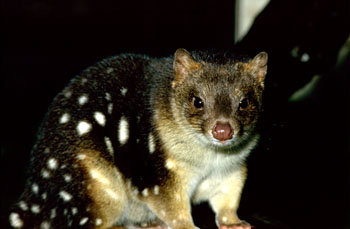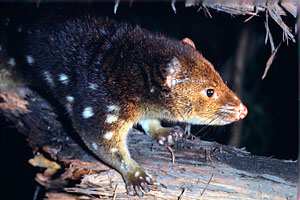
Spot Tailed Tiger Quoll
What is a Tiger Quoll?The spot-tailed quoll, or tiger quoll, is the largest surviving marsupial carnivore on the mainland of Australia. Although an agile climber, the quoll spends most of its time on the forest floor. Quolls are total carnivores that feed on medium-sized animals including possums, gliders, birds and rabbits. For a detailed description of a Tiger Quoll, see Draft Revised Tiger Quoll Action Statement. |
 |
Quoll Threatened by logging
The Otway Ranges was described as the stronghold for the species in 1940 (Fleay). The Spot-Tailed Quoll is now classified as 'Vulnerable' under the Commonwealth Endangered Species Protection Act 1995, and has recently been reclassified to 'Endangered' under the Flora and Fauna Guarantee Act.
When the Quoll was first listed for protection under the Flora and Fauna Guarantee Act (nomination 146), logging practices that cause habitat fragmentation were cited as a major threat.
Spot Tailed Quoll study 1999
As part of the West RFA process, the Commonwealth Government funded a study to investigate the current range, status and distribution of the Spot-Tailed Quoll in the Otway Ranges. This study was undertaken by Chris Belcher and culminated in a report titled The Range, Status and Distribution of the Spot-Tailed Quoll (Dasyurus maculatus) in the Otway Ranges. See report.
Survey locations
The survey was undertaken in 51 sites between February and June 1999. Quolls were recorded at only three sites, two being in the Otway National Park. The other site was in the headwaters of the East Barham River. See Riley's Ridge Wildlife corridor
However other important sites such as the Link Track was not surveyed as well as the headwaters of the Cumberland River, a semi-remote area.
Report findings and recommendations
Belcher's report highlights the "dramatic decline" of Spot Tailed Quoll numbers over the past thirty years with a very limited distribution now occurring in the Otways. The report states that it is "unable to dismiss timber harvesting, habitat fragmentation and poisoning by 1080 as the key disturbances for Spot-tailed Quoll in the Otway Ranges".
Belchers report recommendations include:
1. Strict protection measures must be put in place to
ensure the viability of this species, particularly in the Otway region.
2. Although it is difficult to gain much insight into the causes of the
decline of Quolls due to the very low numbers present, it is obvious that
clearfell logging increases habitat fragmentation and disturbs complex
ecological systems.
3. To more accurately determine the Quoll distribution in the Otway Ranges,
a more intensive, finer scale survey is required.
Tiger Quoll report not available during West RFA Process
Chris Belchers report was suppressed by Forestry Victoria during the West RFA process. A leaked draft report revealed that significant sections of the Otways such as the Cumberland River valley had not been surveyed.
Forest protests in the Cumberland River area highlighted the suppression of the report and brought the issue to the public's attention (Age, Wednesday 16 Feb. 2000).
The controversy embarrassed the government into releasing the final report and doing further survey work in the Cumberland River area. The report was finally released for public comment on Tuesday 22nd February only three days before public submissions to the independent West RFA panel closed.
 Tiger
Quoll
Tiger
Quoll
Tiger Quoll Special Management Zones
In the Otways there are seven Special Management Zones (SMZ) that are designated areas for the conservation of Tiger Quolls. (Also see extract from West RFA regarding SMZs.)
Prey habitat
Each SMZ is 1000 Hectares in which at least 500 Ha must be maintained as suitable "prey habitat" for quolls at any time. Because there is no criteria to determine what constitutes prey habitat for Tiger Quolls, SMZs offer little protection for the quoll from logging.
Forestry Victoria regards 30 year regrowth forest as prey habitat (See point 8 of interim SMZ plan for Wye River area). This contradicts the Flora and Fauna Guarantee Act nomination (100) for Loss of Hollow Bearing Trees that cites that the minimum age of trees to develop hollows is between 120-400 years (depending on species).
Prey habitat depends on the existence of hollow bearing trees and surrounding ecologically intact vegetation for prey fauna such as possums and birds to live in. There should be no assumption that Quolls in the Otways can survive only on ground dwelling prey that can live in 30 year old regrowth.
Logging in SMZs
The West RFA Consultation Paper required a SMZ Plan to be prepared before clearfell logging operations could commence within a Tiger Quoll SMZ. However the requirement to do a SMZ plan to protect Tiger Quolls was dropped when the final RFA was signed.
For more information see Special Management Zone Plans.
Community Action
Concern over the impact of logging on tiger quolls resulted in protest action occuring at Riley's Ridge, and the Cumberland River. Commmunity action resulted in more SMZ areas being created in the Otways during the West RFA. See Public Pressure resulted in more Otways SMZ
Logging is currently on hold in Otway SMZs. See Logging on Hold in Otway SMZ's
Habitat Fragmentation
Clearfell logging in forested wildlife corridors is likely to create habitat fragmentation for Tiger quolls. These areas include:
Tiger Quoll Action Statement
The Spot-tailed Quoll Action Statement (a requirement under the Flora and Fauna Guarantee Act) is currently under review.The final Tiger Quoll Action Statement must develop an accurate definition of prey habitat or provide a process to develop a clear definition. A time to develop such a definition should be provided in the Tiger Quoll Action Statement and with no logging allowed in SMZ pending the definition.
Habitat fragmentation is covered in the draft Tiger Quoll Action Statement but is not regarded as a serious issue for State Forest. The failure to recognise the potential for forestry operations in State Forest to create fragmentation is a serious issue.
References
Fleay, David. (1940) Breeding of the Tiger-Cat. Victorian Naturalist 56, 159-163.
Belcher, Chris. (2000) The Ranges, Status and
Distribution of the Spot-Tailed Quoll (Dasyurus maculatus)
in the Otway Ranges. Commonwealth of Australia.
Don't know the meaning of a word? Check the glossary.